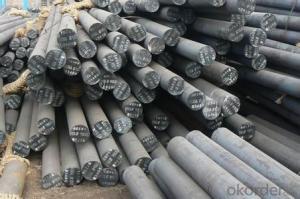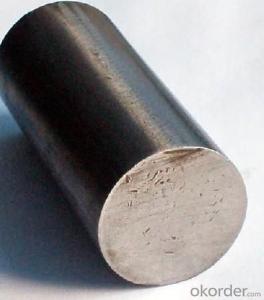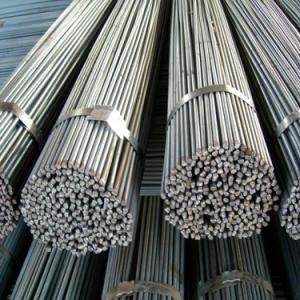cold round bar and gb
- Loading Port:
- China Main Port
- Payment Terms:
- TT OR LC
- Min Order Qty:
- -
- Supply Capability:
- -
OKorder Service Pledge
OKorder Financial Service
You Might Also Like
Product Description:
Specifications of Wire Rod Q235:
Steel Grade: Q235, Standard: GB Diameter: 5.5mm, 6.5mm, 7mm,8mm,9mm,10mm,12mm,14mm
Diameter Tolerance:±0.3mm 6.5mm can be drawing into 2mm/8.0mm can be drawing into 3mm
:
Please kindly find our chemistry of our material based on Q235 as below for your information
Trademark | Rank | Chemical composition (quality score) % | | ||||
C | Si | Mn | S | P | | ||
| | |||||||
| ≤ |
| ≤ | ≤ | | ||
Q235 | A | 0.14-0.22 | 0.30 | 0.30-0.65 | 0.050 | 0.045 | |
Q235 | B | 0.12-0.20 | 0.30 | 0.30-0.70 | 0.045 | 0.045 | |
Trademark | Rank | Pulling Test | | ||||
Bend PointΔs/Mpa | Tensile Strength | Elongation Ratioδ5% | | ||||
| | |||||||
Thickness (Diameter) /MM | Thickness (Diameter) /MM | | |||||
≤16 | 16-40 | | ≤16 | 16-40 | | ||
≥ | | ≥ | | ||||
Q235 | A | 235 | 225 | 375-500 | 26 | 25 | |
Q235 | B | 235 | 225 | 375-500 | 26 | 25 | |
Usage and Applications of Wire Rod Q235:
After hot-rolled the products shaped into coil and delivery as finished product, including round, square, rectangular, hexagonal and so on. Since most of the products are round, it is generally called wire rod. Carbon steel wire rod is widely used in construction and manufacturing. Carbon steel wire rod is mainly used for reinforcement of reinforced concrete and welded structure or reprocessed (roberts , nail, etc.) materials, especially used to produce wire drawing, welding electrode, nails, spring, electronic, precise machinery parts and so on.
Packaging & Delivery of Wire Rod Q235:
Packaging Detail: products are packed in coil and then shipped by container or bulk vessel
Each coil weight: 2-3MT
Delivery Detail: within 45 days after received deposit or LC.
Label: to be specified by customer, generally, each bundle has 1-2 labels
Trade terms: FOB, CFR, CIF
- Q:Are steel round bars suitable for the production of crankshafts?
- Yes, steel round bars are suitable for the production of crankshafts. Steel round bars are commonly used in the manufacturing of crankshafts due to their high strength and durability. Crankshafts need to withstand high levels of stress and load during engine operation, and steel round bars offer the necessary mechanical properties to handle these conditions. Steel round bars can be forged or machined into the desired shape and dimensions required for crankshaft production. Additionally, steel is known for its excellent fatigue resistance, which is crucial for crankshafts as they undergo cyclic loading. Overall, steel round bars are a suitable and widely accepted material for the production of crankshafts in various industries, including automotive and engineering.
- Q:What are the different testing methods used for steel round bars?
- Steel round bars undergo various testing methods to guarantee their quality and suitability for different applications. These methods encompass: 1. Visual Inspection: In this preliminary step, the bars are visually assessed for any discernible defects, such as cracks, surface irregularities, or incorrect dimensions. 2. Dimensional checks: To verify their diameter, length, and straightness, steel round bars are subject to dimensional scrutiny. Accurate measurements are imperative to meet specified requirements. 3. Ultrasonic Testing: Internal defects like cracks, voids, or inclusions are detected by passing ultrasonic waves through the round bars. This method identifies potential weaknesses that could compromise the bars' structural integrity. 4. Magnetic Particle Inspection: By utilizing a magnetic field and magnetic particles, this method identifies surface and near-surface defects like cracks, seams, or laps. It is especially advantageous for ferromagnetic materials like steel. 5. Dye Penetrant Inspection: This technique involves applying a colored dye to the round bars' surface and subsequently wiping it off. The dye seeps into any surface cracks or defects, making them visible under ultraviolet light. 6. Hardness Testing: To gauge the hardness of steel round bars, hardness testing is conducted using methods like Rockwell or Brinell scales. It assists in determining the material's ability to withstand external forces and ensures compliance with required hardness specifications. 7. Tensile Testing: This test measures the maximum load a steel round bar can bear before fracturing, providing insight into the material's strength and ductility. 8. Chemical Analysis: Chemical analysis is performed to ascertain the composition of the steel round bars, including the presence of elements like carbon, manganese, sulfur, phosphorus, and others. It guarantees adherence to the required chemical composition standards. These testing methods are vital in ensuring that steel round bars meet industry standards and customer requirements in terms of quality, reliability, and compliance. Employing a combination of these tests is essential to ensure overall quality and performance in various applications.
- Q:Can steel round bars be used in the manufacturing industry?
- Yes, steel round bars can be used in the manufacturing industry. Steel round bars are versatile and widely used in various manufacturing processes. They can be used for machining, forging, welding, and fabrication to create a wide range of products such as machinery parts, tools, automotive components, construction materials, and more. Steel round bars offer high strength, durability, and excellent resistance to wear, making them suitable for demanding manufacturing applications. Additionally, steel round bars are available in different grades and sizes, allowing manufacturers to choose the most suitable option for their specific requirements.
- Q:How are steel round bars used in the construction of transmission towers?
- Steel round bars are commonly used in the construction of transmission towers due to their strength, durability, and ease of fabrication. These bars are typically made from high-strength carbon steel and are available in various diameters to suit different structural requirements. In the construction of transmission towers, steel round bars are primarily used as the main structural elements. They form the vertical and diagonal members that provide strength and stability to the tower. The bars are typically connected together using various methods like welding or bolted connections to form the lattice structure of the tower. The round shape of the bars allows for uniform distribution of forces, making them ideal for withstanding the loads and stresses that transmission towers experience. These loads include the weight of the tower itself, the electrical conductors, and environmental factors like wind, ice, and seismic forces. Additionally, steel round bars offer excellent corrosion resistance, which is crucial for transmission towers that are often exposed to harsh weather conditions. This resistance helps to prolong the lifespan of the tower and ensures the safety and reliability of the transmission lines. Furthermore, steel round bars can be easily fabricated and customized according to the specific design requirements of the transmission tower. They can be cut, bent, and shaped into the desired dimensions, allowing for flexibility in tower design and construction. Overall, steel round bars play a vital role in the construction of transmission towers by providing strength, durability, and resistance to corrosion. Their versatility and ability to withstand various loads make them an essential component in ensuring the safe and reliable transmission of electricity.
- Q:What are the different types of steel round bars used in the manufacturing of valves and fittings?
- There are several types of steel round bars commonly used in the manufacturing of valves and fittings, including carbon steel round bars, stainless steel round bars, and alloy steel round bars. These different types of steel offer varying levels of strength, corrosion resistance, and durability, allowing manufacturers to choose the most suitable material for their specific application requirements.
- Q:How do steel round bars compare to concrete round bars?
- There are several notable distinctions between steel round bars and concrete round bars. To begin with, steel round bars are composed of a robust and long-lasting material, while concrete round bars are made from a composite material containing cement, aggregates, and water. This dissimilarity in materials grants steel round bars a higher tensile strength and resistance to bending and deformation in contrast to concrete round bars, which are more susceptible to cracking and breaking under stress. Additionally, steel round bars provide greater flexibility in terms of design and customization. They can be easily molded, bent, and trimmed to specific lengths and dimensions, making them highly versatile for various applications. Conversely, concrete round bars are typically available in standard sizes and shapes, thereby limiting their design possibilities. Another crucial aspect to consider is weight. Steel round bars generally have a lighter weight compared to concrete round bars, rendering them easier to handle and transport. This weight advantage also results in reduced structural loads, allowing for more efficient and cost-effective construction. In regard to corrosion resistance, steel round bars necessitate additional protective measures such as coatings or galvanization to prevent rust and corrosion, particularly in humid or marine environments. Conversely, concrete round bars possess natural resistance to corrosion. This factor can significantly influence the long-term durability and maintenance requirements of a structure. Lastly, cost is a pivotal factor to take into account. Although steel round bars may entail a higher initial material cost compared to concrete round bars, their superior strength and durability can result in long-term cost savings. Concrete round bars may require more frequent maintenance and repairs, which can accumulate over time. In conclusion, steel round bars offer superior strength, flexibility, and durability in comparison to concrete round bars. However, the choice between the two is contingent upon the specific requirements of the project, including factors such as design flexibility, weight considerations, corrosion resistance, and cost.
- Q:How do steel round bars compare to plastic round bars?
- Steel round bars and plastic round bars have several key differences that affect their performance and suitability for different applications. Strength and durability: Steel round bars are known for their exceptional strength and durability, making them ideal for applications requiring high load-bearing capacity. They can withstand heavy loads and resist deformation or breakage. On the other hand, plastic round bars are generally less strong and durable, making them more suitable for lighter applications where strength is not a primary concern. Weight: Steel round bars are significantly heavier than plastic round bars due to the difference in material density. This can be an advantage in some applications where additional weight is desired for stability or balance. Plastic round bars, on the other hand, are lighter and can be advantageous in applications where weight reduction is important, such as in aerospace or automotive industries. Corrosion resistance: Steel round bars are known for their excellent corrosion resistance, particularly when they are made from stainless steel. This makes them suitable for applications in harsh environments or exposed to moisture. Plastic round bars, however, are generally more susceptible to degradation due to exposure to UV radiation, chemicals, or extreme temperatures. Therefore, they may not be as suitable for outdoor or corrosive environments. Versatility: Steel round bars offer a wide range of options in terms of size, shape, and grade. They can be machined, welded, bent, or shaped to suit various applications. Plastic round bars also come in different shapes and sizes, but their versatility is somewhat limited compared to steel. They may not be as easily machined or welded, and their performance can be affected by temperature fluctuations. Cost: Steel round bars are generally more expensive than plastic round bars due to the higher cost of raw materials and manufacturing processes. Plastic round bars, on the other hand, are more affordable and can offer cost savings in certain applications. In summary, steel round bars offer superior strength, durability, and corrosion resistance, making them suitable for heavy-duty applications. Plastic round bars are lighter, more affordable, and can be advantageous in applications where weight reduction is important. Ultimately, the choice between steel and plastic round bars depends on the specific requirements of the application and the trade-offs between strength, weight, cost, and corrosion resistance.
- Q:What is the tolerance for length in steel round bars?
- The tolerance for length in steel round bars can vary based on specific manufacturing standards and requirements. Typically, the tolerance is defined as the maximum allowable deviation from the desired length and can be expressed as a percentage or specific measurement in millimeters or inches. Various international standards organizations, such as ASTM or ISO, may have their own guidelines for steel round bar tolerances. These standards ensure consistent and reliable measurements across the industry. In practice, tolerances for steel round bar length can range from tight tolerances of a few millimeters for precision applications to looser tolerances of several centimeters for general-purpose use. It is important to consider that the tolerance may also depend on the size and diameter of the bar. Smaller diameter bars may have tighter tolerances due to the challenges in manufacturing and accurately measuring longer lengths. Ultimately, the specific tolerance for steel round bar length should be determined based on the intended application and relevant industry standards or customer specifications.
- Q:What are the environmental considerations of steel round bars?
- Steel round bars have several environmental considerations. Firstly, the production of steel involves the extraction of iron ore, which can have negative impacts on ecosystems and habitats. The mining process can lead to deforestation, soil erosion, and the release of harmful pollutants into the air and water. Additionally, the manufacturing of steel round bars requires a significant amount of energy, which often comes from non-renewable sources such as coal and natural gas. The burning of fossil fuels for energy contributes to greenhouse gas emissions and climate change. The steel industry is one of the largest emitters of carbon dioxide globally. Furthermore, the transportation of steel round bars can also have environmental consequences. The long-distance shipping of steel products contributes to carbon emissions and air pollution. This is especially significant when steel is imported or exported over large distances. However, it is important to note that steel is a highly recyclable material. Recycling steel reduces the need for new production, conserves energy, and decreases the environmental impacts associated with mining and extraction. By choosing steel round bars made from recycled steel, individuals and industries can contribute to a more sustainable and environmentally-friendly approach. Overall, the environmental considerations of steel round bars include the impacts of mining and extraction, energy consumption during production, and transportation emissions. However, the recyclability of steel offers an opportunity to minimize these environmental impacts and promote a more sustainable steel industry.
- Q:What is the resistance to fatigue of a steel round bar?
- The ability of a steel round bar to resist fatigue refers to its capacity to endure repeated cycles of loading and unloading without failing or deforming. Fatigue resistance is a crucial mechanical property for materials utilized in diverse applications, including structural components, machinery, and automotive parts. Several factors influence the fatigue resistance of a steel round bar, including the specific grade of steel, its microstructure, surface condition, and the applied loading conditions. Steel is widely recognized for its exceptional fatigue resistance in comparison to other materials, which explains its extensive utilization across various industries. The high strength, ductility, and presence of various alloying elements in steel contribute to its resistance to fatigue. These characteristics enable steel to endure cyclic loading without significant deformation or weakening. Moreover, the microstructure of the steel, such as grain size and distribution, significantly impacts its fatigue resistance. Engineers typically conduct fatigue tests, such as rotating beam or axial loading tests, to assess the fatigue resistance of a steel round bar. These tests subject the steel bar to controlled cyclic loading and measure the number of cycles it can withstand before failure occurs. The results determine the fatigue strength or fatigue limit of the steel, representing the maximum stress level it can indefinitely endure without failing. It is important to acknowledge that the fatigue resistance of a steel round bar can vary due to factors like surface defects, stress concentration, and environmental conditions. Therefore, proper design considerations, such as surface treatments, stress reduction techniques, and appropriate loading specifications, are crucial to ensure the desired fatigue performance of the steel round bar in specific applications.
1. Manufacturer Overview |
|
|---|---|
| Location | |
| Year Established | |
| Annual Output Value | |
| Main Markets | |
| Company Certifications | |
2. Manufacturer Certificates |
|
|---|---|
| a) Certification Name | |
| Range | |
| Reference | |
| Validity Period | |
3. Manufacturer Capability |
|
|---|---|
| a)Trade Capacity | |
| Nearest Port | |
| Export Percentage | |
| No.of Employees in Trade Department | |
| Language Spoken: | |
| b)Factory Information | |
| Factory Size: | |
| No. of Production Lines | |
| Contract Manufacturing | |
| Product Price Range | |
Send your message to us
cold round bar and gb
- Loading Port:
- China Main Port
- Payment Terms:
- TT OR LC
- Min Order Qty:
- -
- Supply Capability:
- -
OKorder Service Pledge
OKorder Financial Service
Similar products
New products
Hot products
Related keywords































